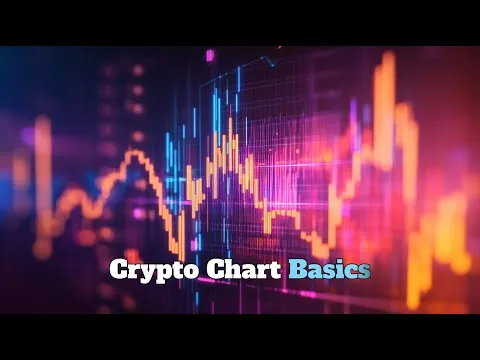Welcome, future crypto enthusiast! You're here because you're curious about how to make cryptocurrency work for you. While the crypto world offers many ways to earn, from passive income to active trading, understanding the market's pulse is key. This guide will walk you through the simplest starting points and then show you how to level up your game by understanding crypto charts.
The Starting Point: Simple Spot Trading
The most straightforward way to earn in crypto is through spot trading. This means simply buying a cryptocurrency (like Bitcoin or Ethereum) on an exchange and holding onto it. Your goal is to buy low and sell high. Many beginners start by 'HODLing' (holding on for dear life) where they buy a solid project and hold it for months or even years, expecting its value to grow over time. This relies on the overall upward trend of the market.
Actionable Step: Open an account on a reputable cryptocurrency exchange (e.g., Coinbase, Binance, Kraken). Start by investing a small amount in a well-established cryptocurrency like Bitcoin (BTC) or Ethereum (ETH). Don't invest more than you can afford to lose.
Next Step: Understanding Charts for Smarter Trades
To move beyond just 'HODLing' and make more informed decisions, you need to understand how to read crypto charts. These charts are essentially a visual history of a cryptocurrency's price movements, helping you predict potential future directions. They are like a treasure map where 'X' marks potential profit spots.
Candlesticks: Your Market Storytellers
Crypto charts are often made of 'candlesticks'. Think of them as individual stories about the price action over a specific period (e.g., 1 hour, 1 day).
- Green candlesticks indicate that the price went up during that period (it closed higher than it opened).
- Red candlesticks mean the price went down (it closed lower than it opened).
Each candlestick also shows the highest and lowest price reached during that period. Learning to spot patterns in these candles can give you hints about buyer and seller behavior.
Spotting Trends: Riding the Wave
The most basic chart analysis involves identifying trends:
- Uptrend: Prices are consistently moving higher, like a staircase going up. This is usually a good time to consider buying if you believe the trend will continue.
- Downtrend: Prices are consistently moving lower. In a downtrend, you might consider selling or waiting for a clearer sign of reversal before buying.
- Sideways/Choppy: Prices are moving without a clear direction, often signaling uncertainty. This is often where patience is required, or a sign to avoid trading until a clearer trend emerges.
Actionable Step: Observe charts on your exchange or a charting platform like TradingView. Try to identify if Bitcoin or Ethereum are in an uptrend, downtrend, or moving sideways. Draw simple lines connecting the highs or lows to visualize these trends.
Beyond the Basics: Using Indicators for Precision
Once you're comfortable with candlesticks and trends, you can use technical indicators for more precise trading. These are mathematical calculations that add lines or values to your chart, helping you confirm trends or spot potential reversals.
Support and Resistance: Price Barriers
Think of support and resistance as invisible floors and ceilings for the price:
- Support: A price level where a cryptocurrency tends to stop falling and often bounces back up. It's like a floor that prevents the price from dropping further. This can be a good buying opportunity.
- Resistance: A price level where a cryptocurrency tends to stop rising and often pulls back down. It's like a ceiling that prevents the price from climbing higher. This can be a good selling opportunity.
Actionable Step: On your charting platform, draw horizontal lines at price levels where the crypto has repeatedly stopped falling (support) or stopped rising (resistance). When the price approaches these lines, pay attention to how it reacts.
Moving Averages: Smoothing Out the Noise
Moving Averages (MAs) smooth out price data to show the average price over a certain period (e.g., 50 days, 200 days). They help confirm trends and identify potential reversals.
- When a shorter-term MA crosses above a longer-term MA (a "Golden Cross"), it often signals a bullish trend.
- When a shorter-term MA crosses below a longer-term MA (a "Death Cross"), it often signals a bearish trend.
RSI (Relative Strength Index): Momentum Checker
The RSI is a momentum indicator that tells you if a crypto is 'overbought' (its price has risen too quickly and might be due for a correction) or 'oversold' (its price has fallen too quickly and might be due for a bounce). It ranges from 0 to 100.
- Above 70: Generally considered overbought. Might be a good time to consider selling.
- Below 30: Generally considered oversold. Might be a good time to consider buying.
Important Considerations: Charts provide clues, not guarantees. The crypto market is highly volatile and can be affected by news, major investors ('whales'), and even social media. Always remember that leverage, while increasing potential gains, also magnifies losses significantly. It's an advanced tool best avoided by beginners.
By starting with simple spot trading and gradually learning to read charts, you'll be better equipped to navigate the exciting, albeit sometimes chaotic, world of cryptocurrency. Remember to practice these skills on demo accounts or with very small amounts before committing significant capital.
